Abstract
An algorithm is a sequence of operations that is used to find a solution to a problem. The sequence of the operations are often well organised so that it may be representable as a flowchart or state-machine when possible. The first few sections of chapter 4 illustrate this by way of clustering algorithm and nature-inspired algorithms. Having laid the fundamental background of artificial neural networks (ANN) in previous chapters, in terms of definitions, theorems, and equations, it is now possible to organise one or more of these elements in such a way that it provide intelligent solution to some problems. The organisation of the elements has led to an attempt to give a formal definition of ANN in this chapter. Important and notable organisation of concepts and definitions may both help in reformulating problems as well as providing solution for them. The suitability of these solutions may be accessed by placing one or more performance metrics on the corresponding ANN as shown in the last section of this chapter. Such is the theme of this chapter.
Keywords: Allele, Chromosome, Covariance matrix, Cross-over, Deoxyribonucleic acid (DNA), Edges, Evolution, Fitness function, Flowchart, Genetic Algorithm (GA), Goodness-of-fit, Hypothesis testing, Mean-Square Error (MSE), Mutation, Nodes, Offspring, Principal Component Analysis (PCA), Ribonucleic acid (RNA), Selection, Walk.






















